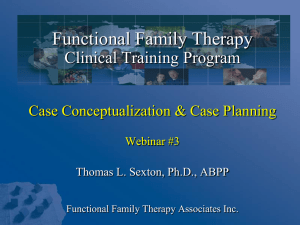Functional Family Therapy for Adolescent Substance Use Disorders
advertisement
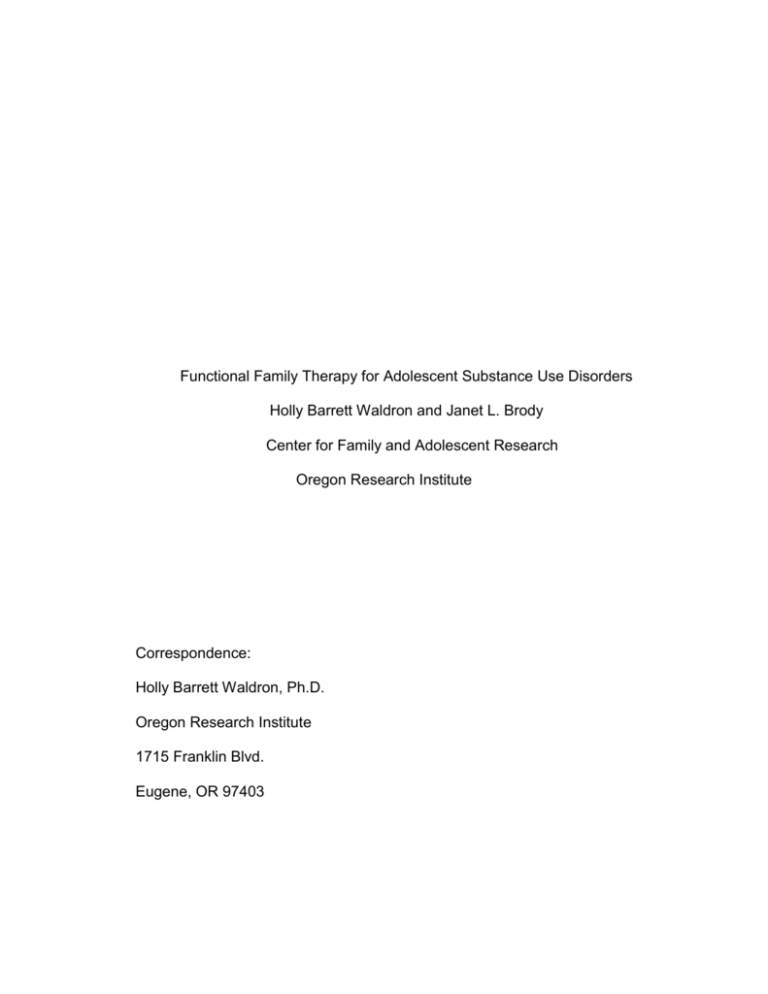
Functional Family Therapy for Adolescent Substance Use Disorders Holly Barrett Waldron and Janet L. Brody Center for Family and Adolescent Research Oregon Research Institute Correspondence: Holly Barrett Waldron, Ph.D. Oregon Research Institute 1715 Franklin Blvd. Eugene, OR 97403 FFT for Substance Use Disorders 2 Overview of the Clinical Problem: Adolescent Substance Use Disorders Adolescent substance use disorders (SUD) encompass a broad spectrum of phenomena involving distinct substances used, a range in quantity and frequency of use, an array of associated problem behaviors, and multiple ecological influences (Winters, Stinchfield, & Bukstein, 2008). SUD is often viewed as just another manifestation of adolescent disruptive behavior. However, the pharmacological effects and physiologically addictive properties of alcohol and illicit drugs have important and unique implications for treatment, relative to treatments for other adolescent disorders. And, unlike other clinical problems, the development and maintenance of SUD may be influenced by the immediate social environment, including the extent of peer and/or parent substance abuse, the availability of substances, and the prevailing societal influences (e.g., tobacco and alcohol taxes, stringent law enforcement, bans on nonprescription medications). Another unique feature of adolescent SUD is that substance use is a covert behavior not always readily apparent to parents, teachers, or other health professionals. The majority of teens with SUD are characterized by lack of motivation to change and resistance to treatment, entering treatment only under a court mandate or in lieu of school suspension. The consequences associated with SUD can be severe. Potential adverse consequences include school failure and drop out, substance-related injuries, and increased risk for STIs, HIV/AIDS, teen pregnancy, violent exchanges, overdose, and death. Substance use can also interfere with crucial developmental tasks, such as prosocial identity formation, interpersonal and educational skill acquisition, and meeting family and work responsibilities (Bentler, 1992). Youth with SUD often have co- FFT for Substance Use Disorders 3 occurring conduct, depressive, bipolar, post-traumatic stress, and anxiety disorders, bulimia, and other problem behaviors (Kaminer & Bukstein, 2008). Evidence indicates that dual diagnosis increases the likelihood of continued problem behaviors and is associated with poorer treatment outcomes. The negative consequences associated with SUD, the co-occurrence of other psychiatric disorders, and the associated problems facing these youth and their families underscores the need for evidencebased practice. The influence of the family on the development and maintenance of substance use problems is widely recognized. Parental and sibling use, family members’ attitudes toward use, poor family management practices, disturbed marital and family relationship functioning, and a host of other family factors have been linked to adolescent substance abuse and have been conceptualized as interdependent and bidirectional influences. Moreover, treatment outcome research has shown that family-based interventions are associated with higher rates of treatment engagement and retention, significant reductions in substance use, and improved functioning in other behavioral domains (Stanton & Shaddish, 1997; Waldron & Turner, 2008). Functional Family Therapy: Characteristics of the Treatment Program The focus of this chapter is the Functional Family Therapy (FFT) approach for adolescents with SUD and their families. FFT is a widely disseminated evidence-based treatment developed for youth with conduct disorder, delinquency, and other disruptive behaviors (Alexander, Parsons, & Pugh et al., 1998). FFT has also been implemented with families of adolescents with SUD (Friedman, 1989; Waldron, Slesnick, Brody, Turner, & Peterson, 2001), and has emerged as a well-established treatment for youth FFT for Substance Use Disorders 4 with alcohol, marijuana, and other illicit substance use disorders (Waldron & Turner, 2008). The purpose of this chapter is to provide an introduction to FFT for clinicians in diverse settings who treat adolescents with SUD and related problem behaviors and to serve as a guide to clinicians already familiar with FFT with respect to integrating strategies for drug abusing youth into their FFT practice. Conceptual Overview The FFT model is an ecological approach that, like other systemic family models, conceptualizes alcohol and drug abuse as problem behaviors that develop and are maintained in the context of maladaptive family relationships (Alexander et al., 1998). Thus, changing family interactions and improving relationship functioning is key to reducing adolescents' involvement with alcohol and other drugs. The essential core and distinguishing feature of family systems models, relative to other treatment models, is that the locus of problem behavior is relational, transcending the individual, and therefore the focus of treatment should also be relational. The FFT model goes beyond systems theory, integrating and conceptually linking behavioral and cognitive intervention strategies to the ecological formulation of the family disturbance. The treatment goals for families of adolescents with substance abuse are to reduce adolescent substance use and other problem behaviors, improve family relationships, and increase adolescents’ productive use of time. Underlying these goals is the emphasis on changing interaction patterns in the family such that the functions served by substance use are met through other, more adaptive behaviors. The specific methods used to achieve treatment goals are accomplished in three distinct phases: Engagement/Motivation, Behavior Change, and Generalization/Termination. Each of the FFT for Substance Use Disorders 5 phases has associated goals, intervention strategies and techniques, and therapist skills. The phases occur in sequence such that the tasks of one phase are completed before the therapist proceeds to the next phase. Contents of the Treatment FFT usually involves 12-16 sessions of 60 to 75 minutes, with sessions scheduled twice weekly at the beginning of treatment to potentiate the initial change process. This is followed by a period of weekly sessions to space learning and allow time between sessions for practice, concluding with sessions that occur several weeks apart as families are able to maintain new behaviors independently. Homework is an integral part treatment and is tailored to the unique tasks of each phase. FFT is designed to include all family members who are living together and any other extended family members or significant others who are central to family functioning. With such an inclusive focus, getting the whole family to become involved in therapy may be the therapist's first great challenge and initial target of intervention. Engagement/Motivation The Engagement/Motivation phase focuses on readiness to change and involves creating the context in which behavior change can occur. The aims are to: 1) engage the family in therapy and begin to develop a therapeutic relationship, 2) enhance the family’s motivation for change, and 3) assess the relevant aspects of individual and family functioning to be addressed in treatment. Engaging families. The process of engaging families relies primarily on creating positive expectations for therapy. A host of variables can influence treatment expectancies, including characteristics of the service delivery system (e.g., reputation, FFT for Substance Use Disorders 6 location, friendliness of staff), family attitudes and beliefs, and therapist characteristics (e.g., age, gender, ethnicity, cultural sensitivity, education, experience, humor, interpersonal warmth). Adopting the language system used by the family, normalizing problems, and expressing confidence are only a few of the many ways therapists can influence family expectations for change. Families with substance use problems frequently enter treatment with an established pattern of interaction involving intense negative affect and malevolent attributions (Waldron & Slesnick, 1998). These patterns and behaviors represent a major impediment to change at the onset of treatment. However, as confrontation is associated with family resistance, maintaining a nonblaming, nonjudgmental tone lowers family defensiveness and hostility and allows change to occur without forcing family members to admit fault for previous failures. The therapist’s aim is to create a cognitive framework compatible with systemic change by offering families a relational perspective on their problems. The primary strategies for motivating families include: 1) emphasizing the connections in thoughts, feelings, and/or behaviors of family members by focusing on the relational aspects of behaviors, rather than on the individual-oriented complaints presented, 2) reframing, and 3) actively managing aversive interactions - all while maintaining a nonblaming stance. FFT therapists also strive for a balanced alliance with family members, taking care to avoid forming a coalition with one family member at the expense of another. Each family member should experience the therapist support while also coming to accept that all family members share in the responsibility for the family’s problems. FFT for Substance Use Disorders 7 Relationship focus. In disturbed families, individuals rarely view their own behavior as contributing to their current difficulties in a contingent or interdependent fashion. Rather, their behavior is often seen as a necessary reaction to the misbehavior of other members. The therapist highlights the interactions between family members to increase their awareness of how they affect each other and how the relationship affects their own behavior. The therapist can facilitate a relationship focus by asking questions and identifying sequences of behavior that focus on the relational impact of family behaviors, thoughts, and feelings and guide the family away from discussions of the adolescent's problem behavior. For example, if a mother is complaining about constantly reminding daughter about her chores and responsibilities, the therapist could turn to another sibling and ask: “Do you need mom to keep after you like your sister? Or is your job to be the “good” child?” Given the context of mother’s blaming, asking such a question redirects the exchange, focuses on family relationships, "takes the heat off" the referred family member, and increases the likelihood that the family will begin to experience the sense that they are “all in this together.” Reframing. Reframing problem behavior is a core technique of FFT aimed at changing the meaning and value of negative emotions and behaviors in the family. If family members can be helped to consider that their own and others’ behaviors are motivated and maintained by variables other than individual malevolence (e.g., anger reflects underlying hurt or worry), they are more likely to see change as possible and become more motivated. Some reframes may focus on motives (e.g., ”So, letting Brett live at home, even though he takes money from your purse, is one way you feel you can make sure he’s FFT for Substance Use Disorders 8 safe and at the same time, keep you from experiencing the loss of having him move out.‘) Other reframes emphasize a common experience shared by all family members and evolve into overarching themes that can be returned to throughout therapy to help re-direct the family focus toward change (e.g., ”A lot of times it sounds like important things don’t get said in this family because you want to protect one another from pain and hurt”). The therapist can use knowledge, inferences, and guesswork about the family in relabeling. This strategy can continue for as many sessions as needed until the negativity is reduced and family members have adopted the shift in perspective. Managing aversive interactions. Actively interrupting families during hostile exchanges is critical to avoid an escalation of the kind of interactions families typically experience at home that allows the family to experience a change, albeit brief, in the usual outcome. Therapists can redirect a hostile exchange using reframing or relational comments, making comments on the process just observed, or the therapist may interrupt the process specifically to slow down the pace of therapy, using summary statements to moderate the rate of exchange. Process comments, like summary statements or relational comments, slow the pace of therapy and help disrupt a negative cycle before it escalates. Process comments can also focus on the meaning family members ascribe to others’ behaviors, can be used to dissect or analyze the points at which interactions become negative, and can be used to interconnect the affect, behavior, and cognitions of family members. One caution in managing aversive interactions, however, is that the traditional counseling technique of reflective listening and expressing empathy in response to a family member’s blaming statement can be FFT for Substance Use Disorders 9 counter-therapeutic. Empathy and reflection may verbally reinforce hostile expressions and escalate aversive exchanges. SUD Engagement/Motivation Strategies The FFT therapist will encounter many different types of family dynamics related to substance use and there is no single approach that will be effective for all families. This section identifies some of the common therapeutic challenges encountered when working with these families and provides examples of specific strategies that may be effective in addressing the issues when they arise. These challenges often require creative use of the standard techniques prescribed in FFT treatment. Establish the “meaning” of substance use in the family. Therapists should attempt to identify current or prior history or experiences that may be exacerbating certain views about substance use. Perhaps substance use “means” different things to different members of the family, and the differences in meaning creates difficulty in communication or understanding individual behavior within the family. For example, suppose mom had a brother who died of a drug overdose. She sees her son using drugs and is very frightened that he will escalate his drug use like her brother did and will die, too. For mom, the son’s drug use means he’s engaging in behavior that is potentially life threatening. Dad, on the other hand, was a drug user in high-school, just like his son, and stopped using over time. For dad, drug use is a “normal” teenage activity that elicits little concern. In a family dynamic like this, mom will tend to address the drug use as zealously as dad minimizes it, leaving her feeling increasingly unsupported and frustrated. The son will receive a mixed message from his parents, hearing tacit approval from dad while engaging in heated exchanges with mom as she FFT for Substance Use Disorders 10 exerts pressure on him to stop using drugs. By examining differences in meaning, the therapist can focus the intervention on providing reframes that highlight the relational nature of the problem: “Mom’s reaction is intense because her life experience leads her to worry more than dad about what might happen to you with the drug use. Dad didn’t suffer the same loss as your mom. For her, this is about making sure nothing bad happens to the son she loves so much. That’s why she tries so hard to control what you’re doing. When mom yells, that’s her way of saying ‘I’m really frightened.’” When parents disagree about the importance of drug use as a problem, the therapist should not directly challenge positive drug use attitudes. Instead, the therapist points out how the difference of opinion limits the ability of the parents to work together as a team, creating bad feelings with the more concerned parent, who ends up feeling less supported. It also sends the message to the adolescent that the more the parents disagree, the more he or she will probably be able to get away with continuing the problem behavior. Punitive stance toward drug use. Some families adopt a rigid, punitive parenting approach in response to drug use, focusing a lot of attention on the drug use behavior. The adolescent is viewed primarily in terms of his problem with drugs (e.g., he is an addict). There is often limited attention to other aspects of the relationship and few positive family interactions. Many times these families tend to get stuck in a cycle of escalating negative consequences. Rules are set for the adolescent, the rules are broken, and then increasing punishments are applied. Privileges are lost (e.g., grounding, no access to car keys, door removed from room, possessions taken away). The adolescent often becomes defiant under these punitive conditions and conflict FFT for Substance Use Disorders 11 escalates. A common trajectory is that parents repeatedly threaten to kick the adolescent out of the house. While this pattern is also common in families facing other adolescent disruptive behaviors, a unique substance-related issue is that a substance use “lapse” is a normative aspect of recovery that can provide a useful opportunity to evaluate the antecedents of the lapse and problem solve how to avoid a recurrence. Thus, parents who define any evidence of substance use as a rule violation and an indicant of treatment failure will likely set the stage for crises that disrupt treatment and interfere with the expected process of recovery. One particularly effective reframe is to offer a longer term perspective for the family, “One of the goals of the family is to help Michael launch into adulthood. It might be time for Michael to move toward independence and living on his own, but we want that to happen as constructively as possible, with your support, so he’s not moving out in anger.” A second strategy for these families is to expand the focus of the relationship beyond the negative emphasis on rules and behaviors to reestablishing a strong positive bond. Strengthening the bond can also serve to increase motivation to change. Homework assignments involving previously enjoyed family activities or new activities that have a high likelihood for success (e.g., send a positive text message) are good ways to begin the process. Parental substance abuse. A particularly challenging situation is the family where one parent is a chronic alcoholic or drug user, and the family enters therapy with the united belief that the parent’s use is responsible for the adolescent’s drug problem. The parent’s acceptance of blame and regular apology for both his own drinking or drug use, as well as for the adolescent’s drug use, serves to perpetuate the drug use. Rather than FFT for Substance Use Disorders 12 accepting the families’ interpretation of the problem, the therapist must reframe the parent’s substance use behavior to provide an alternative relational focus for the problem. “It sounds like it’s been really important to the family to have someone who takes responsibility for all the problems, and that’s clearly your role. I’m wondering whether the family has communicated how important it is to have you available for the other aspects of family life. I’m talking about the fun parts of being a member of this family, like sharing at dinner or coming home early and watching a movie together. And, I’m curious, are you responsible for Sally’s talent in art too, or is mom the one who gets credit for the good stuff?” The intent of this type of reframe is to help the family think about the “roles” in a different way. In this scenario we have a “good parent, bad parent” dynamic that actually reinforces the current behavioral patterns and allows the dysfunctional behavior patterns to continue. By challenging the rigid roles, the therapist helps everyone take responsibility for the dysfunctional behavior, expanding the ways family members can interact. Talking about drug use in sessions. In FFT, the presenting problem is avoided as a topic of discussion because the individual problem behavior is viewed as a symptom of dysfunctional relational pattern and the focus of the intervention is on the relational interactions. However, in families where the substance use is a direct component of the relationship (e.g., family members using together) it is important to highlight the connection between use and relationship contact. Yet, the therapist also needs to avoid allowing the family to focus on drug use content alone and maintain an emphasis on clarifying the meaning of drug use for the relationship. Moreover, the therapist will have to negotiate situations where the parent views their own drug use as acceptable, but FFT for Substance Use Disorders 13 views the adolescent’s use as a problem-behavior. One effective technique in this situation is to use reframing in conjunction with questions about the circumstances and behavioral sequences associated with conjoint substance-using behavior. This is followed by a reframe that emphasizes the positive or negative role the drug use is playing in the relationship, and points to a relational motivation for reducing the use. For example, in response to a mother saying “when we’re using together we’re just able to relax,” the therapist response could be “It’s really important for both of you to share down time and the drugs have helped you do that. It sounds like what we need to do is figure out other ways you two can enjoy each other’s company, because that’s important to you, but we want to do that without the drug use, since the drugs are getting in the way of your son’s success in school.” This approach avoids directly focusing on the parent’s substance use as a “cause” of the adolescent’s drug problem. Therapists should avoid confronting or blaming the parent, since that will result in defensiveness. Instead, the therapist focuses on the relational impact of the drug use, framing the problem as a need to find ways of enhancing the relationship in a manner that does not involve drug use. Assessment Assessment takes place at two levels to identify what change is needed (e.g., drug use, other problem behavior) and how the behavior change needs to occur in order to maintain the functions served by the behavior. Specific recommendations for substance use assessment are reviewed elsewhere (e.g., Winters et al., 2008). The concept of the interpersonal function of behavior is unique to the FFT model and is an essential element in determining how behavior change techniques should be FFT for Substance Use Disorders 14 implemented in the family. By integrating drug use and relationship function information, the therapist can devise a unique plan for each family which takes into account the characteristics and needs of each individual, as well as the fit between these individual characteristics at the relationship level. Relational functions are defined in terms of the interpersonal relatedness or interdependency they allow each family member to achieve with each other. Each family member has a relational function, closeness, distance, or midpointing, with each other member of the family (e.g., mother with son, son with mother, mother with father, father with son). The essence of understanding the interpersonal function of behaviors between members of each dyad is to look at the outcome of the behavior. If a behavior is associated with repeated interaction patterns in families that result in family members experiencing significant physical or psychological separation from one another, then the function of the behavior is distance. If the outcome of behavior is that family members experience greater connection or interdependency, the function is closeness. Some relationships involve a blending of distance and closeness or “midpointing”. While certain behaviors more commonly produce certain functions (e.g., intoxication is distancing), a particular behavior is never assumed to create a specific function. Adolescent drug use could create considerable distance in that the youth spends the majority of free time with other drug-abusing peers. Alternatively, drug use may cue a repeated behavioral sequence in the family that routinely results in increased closeness when mother and father rally around the adolescent in a renewed effort to support him. FFT for Substance Use Disorders 15 Although closeness or intimacy are generally viewed as socially desirable and distance as undesirable, FFT functions are not conceptualized as inherently good or bad. In addition to healthy forms of closeness, "smothering" or enmeshed relationships represent maladaptive forms. While some forms of distance are unhealthy (e.g., isolating oneself from other family members, being nonresponsive), maintaining distance from other people may facilitate the development of independent thinking and a sense of autonomy and competence. Midpointing can also be expressed in either adaptive or maladaptive ways. For example, a young adult with a drug problem may at times use his/her addiction as a way of escaping from the family and at other times use it as a way of connecting with them: "I lost my license, so you need to drive me to work." The identification of the functions for each dyad in the family allows the therapist to develop a change plan that will address maladaptive behaviors while ensuring that each family members functions with others are maintained, thereby increasing the likelihood that behavioral changes will be successful. Behavior Change Behavior Change focuses on establishing and maintaining behavior change both at the individual level and for the family as a whole. In this phase, the motivational framework created and the assessment data obtained in Engagement/Motivation are used to guide the selection and implementation of specific behavioral techniques. The primary goal of this phase is to establish new behaviors and patterns of interaction that will replace old ones, preventing maladaptive patterns from reappearing and producing long-term change in the family. During Behavior Change, techniques are used to change the meaning of behavior, the attributions family members have about one FFT for Substance Use Disorders 16 another, and family members' motivations. While such changes are important prerequisites to long-term change, they will not be maintained unless interaction patterns follow a specific plan. During this phase, therapists draw from a menu of treatment strategies and techniques in order to achieve the objectives for change for each target behavior in the treatment plan. In addition, therapists can implement as needed other specialized evidence-based strategies (e.g., trauma intervention, anxiety management) to tailor treatment to the individual needs of adolescents or families. Strategies are implemented to be consistent with each family member’s interpersonal function with each other family member. An early goal in the behavior change phase is to enhance the family’s experience of positive change by increasing positive activities and interactions. Throughout the behavior change phase, interactions are highly structured and the therapist is active and directive. By maximizing the success experiences of families, the positive momentum and family motivation established in the treatment readiness phase will continue. The specific techniques introduced by the therapist in the behavior change phase can include any strategies or devices capable of changing behavior and accomplishing these goals. The FFT model has not created a new set of techniques for changing behavior. Rather, clinicians are directed to the broader literature on evidence-based cognitive and behavioral treatments to integrate other behavior changed strategies into FFT as needed. The most commonly used Behavior Change session topics are presented in Table 1. Communication and problem-solving skills training are considered core behavior change strategies and are implemented in some form with virtually all FFT for Substance Use Disorders 17 families. Other topics may or may not be used and are presented as a menu of options. In addition, there are a host of technical aids that can be integrated into behavior change sessions to support families’ change efforts (Alexander et al., 1998). The unique emphasis of the FFT model is on the application of techniques in the context of the assessment of functional payoffs in the family and tailored to each set of family relationships. For example, the manner in which the therapist incorporates communication or problem-solving skills into family interactions may range from instituting nightly, formal, family meetings (high contact, low distance) to occasional, informal, "as needed" check-ups between family members or even written notes used to convey messages and solve problems (low contact, high distance). Similarly, community-based approaches such as Alcoholics Anonymous, could be incorporated into treatment, with a father and son with drinking problems attending meetings to together or attending different meetings on alternating nights of the week, again depending on their assessed relationship functions. SUD Behavior Change Strategies There are a variety of behavior change techniques for the unique problems associated with substance abuse. However, the behavior change program selected for families will be based on the specific problems associated with each family and by the family functions identified during the Engagement/Motivation phase. When both the adolescent and the parent are involved in substance use, conducting a functional analysis of their use behavior (i.e., identifying antecedents and consequences of use, as well as the quantity, frequency and circumstances surrounding use) can help reinforce the relational nature of the substance use problems and identify specific ways in which FFT for Substance Use Disorders 18 the adolescent and parent can support each other in reducing use. This technique can be effective in motivating parents to address their own use and can be introduced as an informational exercise for parents who resist changing their own behavior. Despite improvements in family relationships, actual drug use reduction can be hampered by difficulties coping with the urges and cravings associated with the addictive properties of drugs. Several techniques exist for identifying and coping with urges and cravings. One strategy that can be implemented in the behavior change when the adolescent has a contact or midpointing function with one or both parents parent, is to have the adolescent seek support from the parent(s) to help monitor and cope with urges to use. Similarly, relapse prevention techniques can be discussed with the entire family and specific responsibilities can be assigned to family members to help support the adolescent’s sobriety. For example, when the adolescent is invited to a party, if the mother has a distancing function, she can help her daughter figure out what triggers for drug use might come up and be available by phone to pick the daughter up as part of a safety plan. Communication between the adolescent and the parent is often compromised because of escalated reactions to the adolescent’s drug use. A common FFT behavior change strategy to help individuals regulate negative moods and emotions (e.g., anger management, coping with negative thoughts), can be effective in this situation. The process involves examining and challenging automatic and irrational thoughts associated with a particular situation, and then demonstrating the link between these thoughts, negative moods, and poor family communication. (“When I see Adam getting high, it makes me think about my brother who did the same thing and ended up FFT for Substance Use Disorders 19 homeless, spending all his money on drugs, I get so worried that I just yell at him to stop, then he gets mad and we get into a fight”). By challenging the belief that Adam will turn out like her brother, the parent is then able to substitute more useful thoughts, (e.g. “Adam isn’t my brother and it probably is frustrating to him that I keep comparing them. I’m just going to thank him for bringing his dishes down from his room”). This process will de-escalate emotional responses and help the family implement more effective communication strategies. Generalization and Termination The final phase of FFT is designed to facilitate maintenance of behavior change and the generalization of treatment gains to the natural environment. As behavioral changes are established in the family, the focus of therapy shifts toward maintenance of change and establishing the family’s independence from the therapy, with the therapist gradually taking a less active role and the interval between sessions is extended. A key goal of the generalization phase is for families to apply their newly acquired behavioral skills to novel situations outside the therapy room. Families are continually faced with new challenges that can quickly send them back into prior behavior patterns. While still in therapy, it is helpful to review the families’ attempts during the week to use their newly acquired behavior change skills. Even one successful experience using the behavior change strategies outside of the therapy room can be very powerful for motivating families to continue their efforts. Another area of emphasis related to generalizing behavior change is the focus on multiple system issues. Many extrafamilial factors cannot be changed, such as neighborhood crime or availability of specific drugs. However, other factors may be FFT for Substance Use Disorders 20 modifiable for a family, such as responsiveness of school personnel. The therapist may interact directly with legal and educational systems on behalf of the family, particularly during the later stages of therapy when a family is about to complete therapy. In addition, the therapist should help families interact more effectively with extrafamilial influences on their own. For example, an adolescent could be encouraged to use his new communication skills to assertively refuse the offer of drugs in the neighborhood or to ask for help from a teacher at school. A mother may identify ways to support her adolescent by helping him to communicate effectively with a probation officer, or practice for a job interview. The therapist may also help the family anticipate future problems and potential solutions (e.g., how the family will handle a lapse if the adolescent ends up using at a party, steps can mom take to calm herself when she angry, how parents resolve disagreements about punishment when their son comes home high). By helping families anticipate appropriate solutions, the therapist will increase the possibility that the families will respond effectively when situations arise, further solidifying their use of behavior change techniques. Therapy moves toward termination when 1) drug and alcohol use and other problem behaviors are reduced or eliminated, 2) adaptive interaction patterns and problem solving styles have been developed and occur independent of the therapist, and 3) the family appears to have the necessary motivation, skills, and resources to maintain a positive clinical trajectory without the support of ongoing services. Evidence on the Effects of Treatment FFT for Substance Use Disorders 21 FFT has received considerable research attention during the past 25 years. Initially developed and evaluated for crisis intervention with juvenile offenders and their families, the effectiveness of FFT has been replicated across sites and settings for substance use problems and a wide range of other problem behaviors (Alexander et al., 1998; Barton, Alexander, Waldron, Turner, & Warburton, 1985; Gordon, Graves, & Arbuthnot, 1995; Klein, Alexander, & Parsons, 1976). The FFT was evaluated by Friedman (1989) in a randomized trial involving 135 families of youth between the ages of 14 and 21 years presenting with heavy alcohol and drug use (e.g., daily cannabis use). Friedman compared FFT to a parenting skills group intervention. Both the FFT and parent training groups showed significant reductions in substance use of more than 50% at follow-up, with improvements in other areas of functioning as well. Although no differences were found between the two treatment groups for treated families, engagement rates differed dramatically (93% in FFT versus 67% in the parenting condition). In a re-analysis of the entire “intent-to-treat” sample (i.e., including treatment drop-outs as failures), Stanton and Shadish (1997) found significantly greater substance use reductions for FFT than the comparison condition. Tentative support for FFT was also found in a study conducted by Lewis, Piercy, Sprenkle, and Trepper (1990) with 136 youth described as “regular” substance users. They compared an integrative family therapy model, described as a combination of elements drawn from Functional Family Therapy and structural strategic systems therapy, to a didactic, family-oriented parenting skills intervention similar to Friedman’s parent group and an educational intervention which included all family members. The FFT for Substance Use Disorders 22 integrated treatment and a parenting skills intervention both showed significant pre- to post-treatment reductions in drug use, with a greater percentage of youth in family therapy decreasing their use. Although the family intervention involved an adapted form of FFT, the findings provide additional indirect support for the model with SUD youth. More recently, we conducted a series of three randomized trials comparing FFT to group and/or individual cognitive behavior therapy (CBT). In the first study, referred adolescents were randomly assigned to either FFT, individual CBT, a combined FFT and individual CBT intervention, or a group skills-based intervention (Waldron et al., 2001). Adolescents (n=120) received 12 hours of FFT, CBT, or group, or 24 hours of therapy in the combined condition (Waldron et al., 2001). Adolescents (N=129) ranged in age from 13 to 17 years (X = 15.54), with 23% of the sample female. Families included: Hispanic (35%), Anglo (41%), Native American (6%), and Mixed (15%). Substance use, including self-report and urine toxicology screening, was measured at baseline and 4-, 7-, and 19 months following treatment initiation. Adolescents in both of the FFT conditions showed significant reductions in the percent days using marijuana from baseline to the 4-month follow-up. Significant reductions also occurred at the 7-month and the 19 month assessments. Adolescent marijuana use in the group condition was not significantly lower than baseline at the 4month assessment, but it was significantly lower at the 7-month and 19-month assessments. The CBT condition was not significantly different from baseline at any of the three followup measurement conditions. The findings supported the short-term benefit of FFT for substance-abusing youth. A second study focusing on alcohol extended the work of the marijuana study (cf. FFT for Substance Use Disorders 23 Waldron & Turner, 2008). In this trial, drinking teens (n =146) were randomly assigned the same four intervention conditions, although in this study the combined FFT and CBT treatment was integrated so that treatment dose was equated with the other conditions (14 sessions). In this integrated condition, families were scheduled to receive approximately 8 FFT sessions. In all other respects, the two studies were virtually identical. Because drinking teens also used marijuana and other illicit drugs, the primary dependent variables included percent days of alcohol use and of marijuana use in the past 3 months. .All four conditions were associated with significant reductions in the percent days of alcohol use from pre- to post-treatment. Significant reductions in marijuana use were also shown in the FFT only and individual CBT conditions. Thus, FFT and CBT were the only conditions associated with improvement for both alcohol and marijuana. A third randomized trial, a two-site study conducted in New Mexico and Oregon, evaluated the efficacy of our integrated FFT+CBT intervention relative to CBT alone for Anglo and Hispanic drug-abusing adolescents across two project sites, one in New Mexico and the other in Oregon (cf. Waldron & Turner, 2008). Each site included 60 Anglo and 60 Mexican American youth. In addition, the New Mexico site included 60 New Mexican Hispanic youth, a primarily English-speaking, highly acculturated Hispanic group with a 500 year presence in the state. Both interventions involved 14 sessions, with approximately 8 FFT sessions in the integrated condition. Assessments occurred at baseline and 5-, 8-, and 18 months following treatment initiation. Results of the analysis for Hispanic participants revealed a statistically significant treatment condition by time interaction. To further evaluate the interaction effect, we FFT for Substance Use Disorders 24 compared the difference between treatments at each assessment. We found significant reductions from baseline to 5-month follow-up for both conditions, with significantly greater reductions for the FFT+CBT condition. No differences were found between the two groups at later follow-ups. A similar analysis was performed for the Anglo sample. The analysis revealed a statistically significant main effect for time, with no differences between the two treatments. Anglo youth in FFT and in CBT showed significant reductions in drug use at each post treatment assessment point. Outcomes for our three FFT studies were included in a recent meta-analytic study (Waldron & Turner, 2008). In this meta-analysis, we examined 46 different treatment conditions that included 2,307 adolescents treated for SUD. The combined sample evaluated several family therapy models, including FFT, group CBT, individual CBT, and a minimal treatment condition. The effect size for the pre- to post-treatment change in the minimal treatment condition was 0.21, which reflected a significant reduction in drug use. For families who received FFT, the effect size for the change from pre- to post-treatment was 0.65, a significantly larger effect than for the minimal treatment condition. For families who received a lighter dose of FFT (8 sessions) when FFT was offered in combination with CBT, the effect size for the pre- to post-treatment change was 0.36. While this effect size reflects a significant reduction in drug use, it is not significantly different from the minimal treatment condition. Thus, the strongest support for FFT for the three clinical trials included in the meta-analysis was for the higher dose of FFT. Directions for Research Individual adolescent outcomes in SUD treatment research have varied widely FFT for Substance Use Disorders 25 across randomized clinical trials. Because no single treatment approach appears to be equally efficacious for all youth, research focusing on understanding who might benefit from particular treatments, including FFT, is a high priority. Moreover, given relapse trajectories for a substantial subgroup of treated youth, FFT strategies designed to enhance the maintenance of treatment gains among youth at risk for relapse are urgently needed. One approach that has potential for addressing problems associated with variability in treatment response is adaptive, progressive treatments (Collins, Murphy, & Bierman, 2004). Although FFT allows tremendous flexibility in implementation, the basic model does not take into account the breadth of individual differences in the presentation of adolescent SUD that might make aspects of the approach less relevant or inefficient for certain individuals. In adaptive research designs, treatment algorithms that vary treatment components and dosages in response to the needs of the individual are used to guide clinical decision-making. In FFT, early treatment responders could “step out” of treatment with follow-up or “booster” sessions offered as needed, while non-responders could progress to FFT with a contingency management component involving incentives earned for family therapy compliance and achievement of drug abstinence. Another major research direction involves understanding the parameters surrounding the efficient transfer of FFT into community settings. Through a formal dissemination organization, FFT has been established in more than 250 clinical settings world-wide. Yet, research examining the transfer process has been rare. Poor adherence of therapists to treatment models has been cited as one of the major limitations to successfully establishing evidence-based practices outside of research FFT for Substance Use Disorders 26 settings. Research linking specific training and supervision approaches to treatment adherence and outcome could inform administrators and treatment providers in clinical service delivery systems regarding sustainable implementation practices. Improved implementation could have a substantial impact on increased FFT services for SUD youth. Such research could also examine the organizational and system-level variables related to treatment utilization and outcomes. Future research should also include an emphasis on mechanisms associated with FFT effectiveness. In particular, process-outcome research is essential within all phases of FFT to increase our understanding of how manual-guided interventions should be implemented or could be enhanced. Such research could also examine how therapist behavior is linked to changes in adolescent and family functioning. Conclusions FFT is an integrated systems and behavioral family-based intervention in which SUD is conceptualized as a problem behavior that develops and is maintained in the context of maladaptive family relationships. The intervention is designed to change family interactions as a means for reducing adolescents' involvement with alcohol and illicit drugs. Taken together, FFT outcome studies have demonstrated consistent decreases in substance use from baseline to follow-up. Moreover, a recent metaanalysis showed that FFT was superior to treatment as usual. Research is needed to identify SUD youth most likely to benefit from FFT and to enhance the FFT intervention to improve outcomes for youth at risk for relapse. Future research should also begin to evaluate individually tailored adaptive, progressive approaches for integrating FFT into a continuum of SUD treatments, to examine the process of dissemination of FFT into FFT for Substance Use Disorders 27 community settings, and to identify mechanisms associated with treatment effectiveness. FFT for Substance Use Disorders 28 References Alexander, J. F., Parsons, B. V., Pugh, C. et al. (1998). Blueprints for violence prevention. Colorado: Venture. Barton, C., Alexander, J. F., Waldron, H., Turner, C. W. & Warburton, J. (1985). Generalizing treatment effects of Functional Family Therapy: Three replications. Journal of Marriage and Family Therapy, 13, 16-26. Bentler, P. M. (1992). Etiologies and consequences of adolescent drug use: Implications for prevention. Journal of Addictive Diseases, 11, 47-61. Collins, L. M., Murphy, S. A., & Bierman, K. L. (2004). A conceptual framework for adaptive preventive interventions. Prevention Science, 5, 185-196. Friedman, A. S. (1989). Family therapy vs. Parent groups: Effects on adolescent drug abusers. American Journal of Family Therapy, 17, 335-347. Gordon, D. A., Graves, K., & Arbuthnot, J. (1995). The effect of functional family therapy for delinquents on adult criminal behavior. Criminal Justice and Behavior, 22, 6073. Kaminer, Y., & Bukstein, O. G. (Eds.) (2008). Adolescent Substance Abuse: Psychiatric Cormorbidity and High-Risk Behaviors. New York: Routledge. Klein, N. C., Alexander, J. F., & Parsons, B. V. (1976). Impact of family systems intervention on recidivism and sibling delinquency: A model of primary prevention and program evaluation. Journal of Consulting and Clinical Psychology, 45, 469474. Lewis, R. A., Piercy, F. P., Sprenkle, D. H., & Trepper, T. S. (1990). Family-based interventions for helping drug-abusing adolescents. Journal of Adolescent Research, 5, 82-95. FFT for Substance Use Disorders 29 Stanton, M. D., & Shadish, W. R. (1997). Outcome, attrition, and family/couples treatment for drug abuse: A review of the controlled, comparative studies. Psychological Bulletin, 122, 170-191. Waldron, H. B., & Slesnick, N. (1998). Treating the family. In. W. R. Miller & N. Heather (Eds.), Treating addictive behaviors: Processes of change (2nd ed.) pp. 271-285. New York: Plenum. Waldron, H. B., Slesnick, N., Brody, J. L., Turner, C. W., & Peterson, T. R. (2001). Treatment outcomes for adolescent substance abuse at 4- and 7-month assessments. Journal of Consulting and Clinical Psychology, 69, 802-813. Waldron, H. B., & Turner, C. W. (2008). Evidence-based psychosocial treatments for adolescent substance abuse. Journal of Clinical Child & Adolescent Psychology, 37, 238-261. Winters, K. C., Stinchfield, R., & Bukstein, O. G. (2008). Assessing adolescent substance use and abuse. In Y. Kaminer & O. G. Bukstein (Eds.), Adolescent Substance Abuse: Pyschiatric Cormorbidity and High-Risk Behaviors. (pp. 5385). New York: Routledge. FFT for Substance Use Disorders 30 Author Note This research was supported in part by grants from the National Institute on Drug Abuse (R01 DA11955; R01DA13350; R01DA13354) and National Institute on Alcohol Abuse and Alcoholism (R01 AA12183). We are also grateful to Hyman Hops for his ongoing support of our efforts and his editorial feedback on drafts of this manuscript. Correspondence concerning this article should be addressed to Holly Barrett Waldron, Ph. D., Oregon Research Institute, 1715 Franklin Blvd., Eugene, Oregon 97403 or via electronic mail at holly@ori.org. FFT for Substance Use Disorders 31 Table 1 Menu of Behavior Change Session Topics ________________________________________________________________ Increasing Pleasant Family Activities Communication Training (“Feeling Heard”) Problem-Solving Skills Anger Management Depression and Negative Mood Management Assertiveness Training Contingency Management Functional Analysis of Substance Use Behavior Coping with Drug and Alcohol Urges and Cravings Substance Refusal Skills Decision-Making for Drug Avoidance (“Seemingly Irrelevant Decisions”) Enhancing Behaviors that Compete with Drugs Relapse Prevention Job Skills ________________________________________________________________
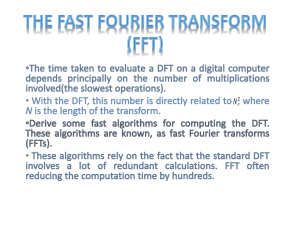
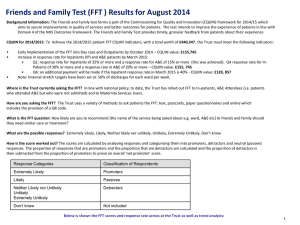
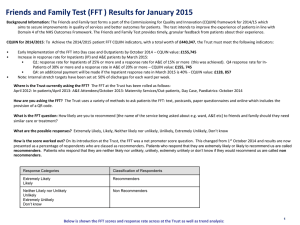
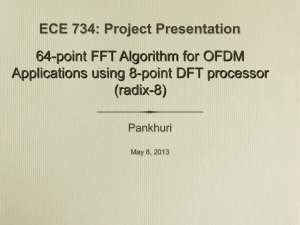
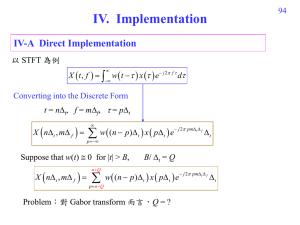
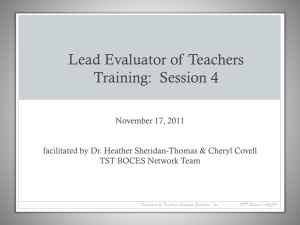
![Y = fft(X,[],dim)](http://s2.studylib.net/store/data/005622160_1-94f855ed1d4c2b37a06b2fec2180cc58-300x300.png)
